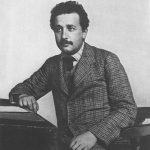Podcast: Play in new window | Download
Subscribe: RSS

Einstein, one of the founders of quantum mechanics
Quantum mechanics is the study of the very tiny; the nature of reality at the smallest scale. It’s a science that defies common sense, and delivers no helpful analogies. And yet it delivers the goods, making scientific predictions with incredible accuracy. Let’s look into the history of quantum theory, and then struggle to comprehend its connection to the Universe.
|
Shownotes
- Quantum Mechanics — Standford U
- Visual Quantum Mechanics — KSU
- Video: Quantum Mechanics for Dummies
- Kinematics
- How can light be both a wave and a particle? — The Straight Dope
- Episode 83: Wave Particle Duality
- Spectral lines — Colorado U
- Spectra of an atom — Colorado U
- Interpreting Emission Line Spectra — U of Alabama
- MASER — Stanford U
- History of Quantum Mechanics
- Plum Pudding Model
- The Ultraviolet Catastrophe — Michael Richmond
- Animations for Quantum Mechanics
- Heisenberg Uncertainty Principle — Stanford U
- Particle spin up and spin down — Wiki
- Pauli Exclusion Principle – Colorado U
- Graviton — Cornell U
- Newtonian Mechanics, or Classical Mechanics — Wiki
- An intuitive look at Quantum Mechanics — LessWrong
